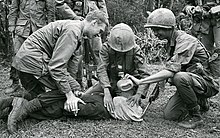
Back الإيهام بالغرق Arabic Катаванне вадой Byelorussian জলপীড়ন Bengali/Bangla Waterboarding Czech Dŵr-fyrddio Welsh Waterboarding Danish Waterboarding German Dronimita torturo Esperanto Submarino (tortura) Spanish القای حس غرقشدن Persian
The examples and perspective in this article deal primarily with the United States and do not represent a worldwide view of the subject. (April 2016) |

Waterboarding is a form of torture in which water is poured over a cloth covering the face and breathing passages of an immobilized captive, causing the person to experience the sensation of drowning. In the most common method of waterboarding, the captive's face is covered with cloth or some other thin material and immobilized on their back at an incline of 10 to 20 degrees.[1][2] Torturers pour water onto the face over the breathing passages, causing an almost immediate gag reflex and creating a drowning sensation for the captive.[3][4][5] Normally, water is poured intermittently to prevent death; however, if the water is poured uninterruptedly it will lead to death by asphyxia. Waterboarding can cause extreme pain, damage to lungs, brain damage from oxygen deprivation, other physical injuries including broken bones due to struggling against restraints, and lasting psychological damage.[6] Adverse physical effects can last for months, and psychological effects for years.[7] The term "water board torture" appeared in press reports as early as 1976.[8]
Waterboarding has been used in diverse places and at various points in history, including the Spanish and Flemish Inquisitions, by the United States military during the Philippine–American War, by Japanese and German officials during World War II,[9] by the French in the Algerian War, by the U.S. during the Vietnam War and the war on terror,[9] by the Pinochet regime in Chile,[10] by the Khmer Rouge in Cambodia, by British security forces during the Troubles,[11] and by South African police during the Apartheid era.[12] Historically, waterboarding has been viewed as an especially severe form of torture.[13]
- ^ "Waterboarding". Quaker Initiative to End Torture. Archived from the original on 10 December 2014. Retrieved 26 June 2018.
- ^ Mark Benjamin (9 March 2010). "Waterboarding for dummies". Salon.
After immobilizing a prisoner by strapping him down, interrogators then tilted the gurney to a 10-15 degree downward angle, with the detainee's head at the lower end. They put a black cloth over his face and poured water, or saline, from a height of 6 to 18 inches, documents show. The slant of the gurney helped drive the water more directly into the prisoner's nose and mouth.
- ^ Safire, William (2008). Safire's Political Dictionary. Oxford University Press. p. 795. ISBN 978-0-19-534334-2.
Waterboarding. A form of torture in which the captive is made to believe he is suffocating to death under water
- ^ Davis, Benjamin (8 October 2007). "Endgame on Torture: Time to Call the Bluff". Archived from the original on 20 December 2007. Retrieved 11 February 2010.
- ^ Ross, Brian; Richard Esposito (18 November 2007). "CIA's Harsh Interrogation Techniques Described". ABC News. Retrieved 17 April 2009.
- ^ "Open Letter to Attorney General Alberto Gonzales". Human Rights Watch. 5 April 2006. Retrieved 17 April 2009.
- ^ Mayer, Jane (14 February 2008). "Outsourcing Torture". The New Yorker. Retrieved 17 April 2009.
- ^ Safire, William (9 March 2008). "On Language: Waterboarding". The New York Times. Retrieved 17 April 2009.
- ^ a b Cite error: The named reference
walter20061005was invoked but never defined (see the help page). - ^ Cite error: The named reference
soliswas invoked but never defined (see the help page). - ^ McClements, Freya (26 June 2017). "Papers alleging British Army waterboarding in NI uncovered". Irish Times.
- ^ Cite error: The named reference
politifactwas invoked but never defined (see the help page). - ^ Cox 2018, p. 488.
© MMXXIII Rich X Search. We shall prevail. All rights reserved. Rich X Search